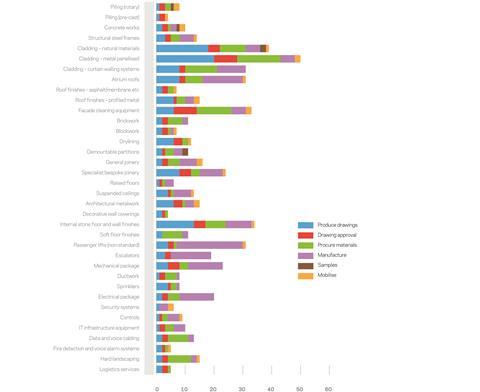Our last look at lead times back in December revealed zero change, but this quarter three packages report a shortening of lead times – reflecting the beginning of a decline in enquiries
01 / Going up
â–² Architectural metalwork
02 / Staying level
â–¶ Piling (precast)
â–¶&²Ô²ú²õ±è;Concrete works
â–¶&²Ô²ú²õ±è;Cladding – natural materials
â–¶&²Ô²ú²õ±è;Cladding – metal panellised
â–¶&²Ô²ú²õ±è;Cladding – curtain walling systems
â–¶&²Ô²ú²õ±è;Atrium roofs
â–¶&²Ô²ú²õ±è;Roof finishes – asphalt/membrane
â–¶&²Ô²ú²õ±è;Roof finishes – profiled metal
â–¶&²Ô²ú²õ±è;Facade cleaning equipment
â–¶&²Ô²ú²õ±è;Brickwork
â–¶&²Ô²ú²õ±è;Blockwork
â–¶&²Ô²ú²õ±è;Metal doors
â–¶&²Ô²ú²õ±è;Drylining
â–¶&²Ô²ú²õ±è;Demountable partitions
â–¶&²Ô²ú²õ±è;General joinery
â–¶&²Ô²ú²õ±è;Specialist bespoke joinery
â–¶&²Ô²ú²õ±è;Raised floors
â–¶&²Ô²ú²õ±è;Suspended ceilings
â–¶&²Ô²ú²õ±è;Decorative wall coverings
â–¶&²Ô²ú²õ±è;Internal stone floor and wall finishes
â–¶&²Ô²ú²õ±è;Soft floor finishes
â–¶&²Ô²ú²õ±è;Escalators
â–¶&²Ô²ú²õ±è;Electrical package
â–¶&²Ô²ú²õ±è;Mechanical package
â–¶&²Ô²ú²õ±è;Ductwork
â–¶&²Ô²ú²õ±è;Sprinklers
â–¶&²Ô²ú²õ±è;Security systems
â–¶&²Ô²ú²õ±è;Controls
â–¶&²Ô²ú²õ±è;IT Infrastructure equipment
â–¶&²Ô²ú²õ±è;Data and voice cabling
â–¶&²Ô²ú²õ±è;Fire detection and voice alarm systems
â–¶&²Ô²ú²õ±è;Hard landscaping
â–¶ Logistics services
03 / Going down
â–¼ Piling (rotary)
â–¼ Structural steel frames
â–¼ Passenger lifts (non-standard)
04 / Lead times summary
Rotary piling â–¼ lead times have reduced by two weeks to eight weeks. Demand in the next six months is quieter but no change is expected in lead times.
Pre-cast piling ▶ lead times remain at four weeks, and workload over the next six months remains the same – the anticipated reduction did not materialise.
Concrete works ▶ lead times remain the same at 10 weeks: contractors’ enquiry levels remain static and no change in lead times over the next six months is expected.
Structural steel frames â–¼ lead times appear to have peaked, reducing by three weeks to 14 weeks. Enquiries have fallen but contractors predict no further change in lead times in the next six months.
Cladding – natural materials ▶ lead times remain at 39 weeks, with no change reported, while cladding – metal panellised systems ▶ lead times remain at 50 weeks with contractors anticipating potential for increases in the next six months.
Cladding – curtain walling system ▶ lead times remain at 31 weeks, with increases forecast in the next six months.
Atrium roof ▶ lead times remain at 31 weeks with no changes reported. Roof finishes – asphalt/membrane ▶ lead times remain at seven weeks and, roof finish – profiled metal ▶ lead times remain at 15 weeks: for both, with enquiries and workload steady, contractors expect no change in lead times.
Facade cleaning equipment â–¶ lead times remain at 33 weeks. Contractors continue to be busier with increased enquiries compared to six months ago but do not anticipate any change over the next six months.
Brickwork â–¶ lead times remain at 11 weeks and blockwork â–¶ at seven weeks; no changes in lead times are anticipated over the next six months.
Drylining â–¶ lead times remain at 12 weeks, with no rise in lead times anticipated over the next six months.
Demountable partitions â–¶ lead times remain at 11 weeks with no change likely in the next six months.
General joinery â–¶ lead times remains at 16 weeks with the potential for increases in the next six months, due to some contractors experiencing increases in workload and enquiries.
Specialist joinery â–¶ remains at 24 weeks but with rises in workload and enquiries contractors anticipate lead times increasing over the next six months.
Raised floors â–¶ lead times remain at six weeks with no changes reported, despite increased workload and enquiry levels.
Suspended ceiling â–¶ lead times remain at 13 weeks with no change reported.
Architectural metalwork â–² lead times have increased by a week to 15 weeks, with drawing approval taking longer, but no further increases are anticipated in the next six months.
Decorative wall covering â–¶ lead times remain at four weeks with no change anticipated in the next six months. Workload and enquiries remain static.
Internal stone floor and wall finishes â–¶ lead times remain at 34 weeks, while soft floor finish lead times remain at 11 weeks. No changes are anticipated.
Passenger lift – non-standard â–¼ lead times have reduced by four weeks to 31 weeks, but companies do not anticipate any further changes for next six months. ·¡²õ³¦²¹±ô²¹³Ù´Ç°ù&²Ô²ú²õ±è;â–¶ lead times remain at 19 weeks.
Electrical package â–¶ lead times remain at 20 weeks, as the previously reported increase in workload has not impacted on lead times. Companies do not forecast any increase in the next six months.
Mechanical package â–¶ lead times remain at 23 weeks, as the previously reported increase in enquiry levels has materialised into companies being busier. No change in lead times is predicted.
¶Ù³Ü³¦³Ù·É´Ç°ù°ì&²Ô²ú²õ±è;â–¶ lead times remain at eight weeks with no change forecast for the next six months.
³§±è°ù¾±²Ô°ì±ô±ð°ù²õ&²Ô²ú²õ±è;â–¶ lead times remain at eight weeks; as contractors’ workload has levelled off they do not forecast a rise in lead times over the next six months.
Security systems â–¶ lead times remain at six weeks with no changes reported. °ä´Ç²Ô³Ù°ù´Ç±ô²õ&²Ô²ú²õ±è;â–¶ lead times remain at nine weeks. Enquiries and workload remain stable with no changes in lead times anticipated.
IT infrastructure equipment â–¶ lead times remain at 10 weeks, while data and voice cabling lead times remain at 13 weeks with no changes forecast. Fire detection and voice alarm systems â–¶ lead times remain at five weeks.
Hard landscaping â–¶ lead times stay at 15 weeks.
Logistics services â–¶ lead times remain at five weeks, with no change forecast.
As previously reported, the market levelled off last quarter and as anticipated it is now showing signs of beginning to decline, with lead times reducing across three packages. Companies are continuing to experience a reduction in levels of enquiries. Only architectural metalwork is experiencing an increase in lead times, due to delays in drawing approval.

Data capture and analysis by Mace Business School. For more details on the article and the contributors please visit .
























No comments yet